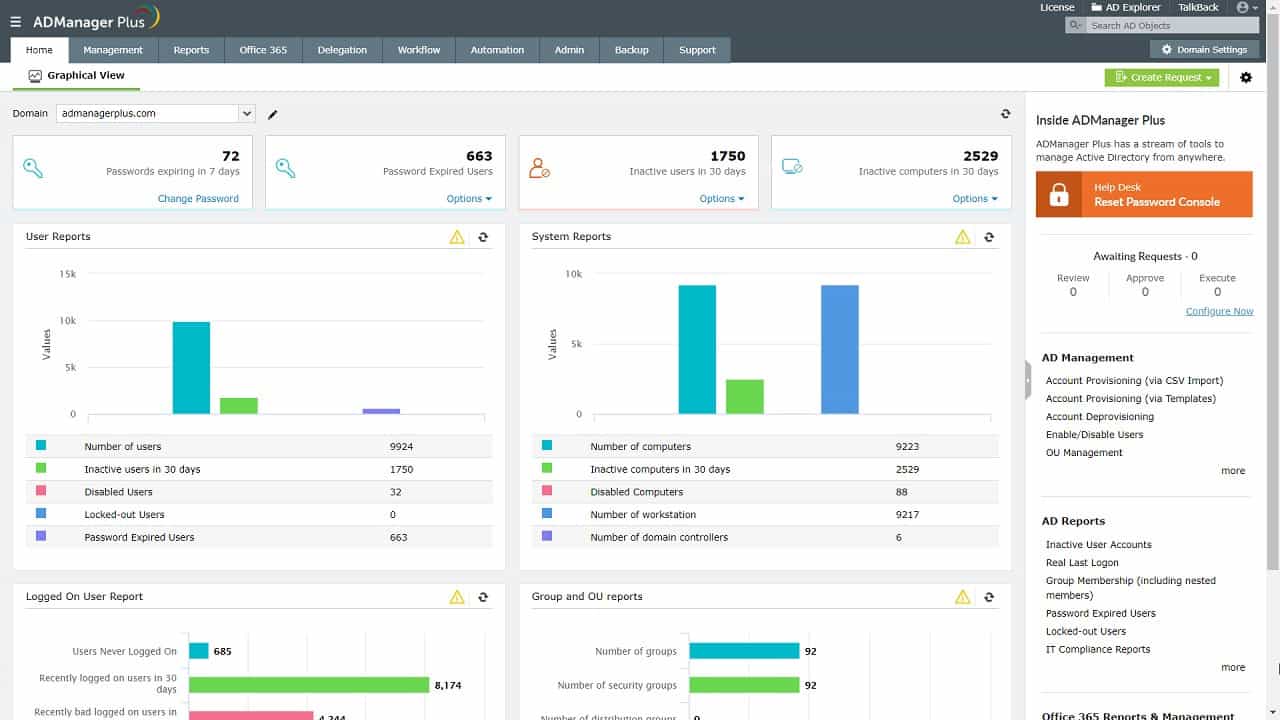We may earn a commission if you make a purchase through the links on our website.
The Best Active Directory Automation Tools

UPDATED: September 2, 2024
Active Directory (AD) automation tools are software solutions designed to streamline and automate the management of Active Directory environments. These tools leverage automation to perform routine tasks such as user provisioning, password resets, group management, and policy enforcement more efficiently than manual methods. They often provide intuitive user interfaces, reporting capabilities, and scheduling features that simplify administration and enhance accuracy.
Here is our list of useful AD automation tools:
- ManageEngine ADManager Plus – FREE TRIAL An all-in-one automation tool for Active Directory, Azure, Microsoft Exchange, and Microsoft 365. Access a 30-day free trial.
- Adaxes A standalone AD automation tool that serves as a proxy between users and your Active Directory, and other applications.
- Microsoft PowerShell A powerful task automation framework that enables administrators to automate a wide range of Active Directory tasks, among others.
- Netwrix Auditor Full visibility into activities within your Active Directory and Group Policy.
- Quest Active Administrator An AD automation solution from Quest Software for enhancing your efficiency and agility beyond what native tools offer.
- Active Directory Users and Computers A built-in GUI management tool for administering various AD objects, provided as part of the Windows Server operating system.
Using AD automation tools can significantly enhance AD management by reducing the potential for human error and freeing up administrative time. By automating these processes, organizations can improve operational efficiency, strengthen security posture, and ensure compliance with internal and external regulations. In this article, we explore six useful AD automation tools available today.
The Best Active Directory Automation Tools
Our methodology for selecting an AD Automation Tool:
When compiling the list of useful AD automation tools, I considered the following key factors in making the selection:
- Core Functionalities: The tool should offer essential features like user provisioning, group management, password resets, and reporting.
- Automation Capabilities: Robust automation features, including workflow automation and bulk operations, are crucial.
- Integration with Existing Tools: Compatibility with other IT management systems is essential for seamless operations.
- Security and Compliance: The tool should prioritize data security and adhere to industry regulations.
- Scalability: The ability to handle growing AD environments is essential.
- User Interface: A user-friendly interface enhances usability and reduces training time.
- Cost-Benefit Analysis: The tool's pricing should align with the expected return on investment.
- Vendor Support: Reliable customer support is crucial for troubleshooting and assistance.
- Deployment Options: Consider on-premises, cloud-based, or hybrid deployment models.
1. ManageEngine ADManager Plus – FREE TRIAL
ManageEngine ADManager Plus is an Active Directory management tool offering automation, reporting, and security features. It streamlines user provisioning, simplifies group management, and provides in-depth insights into AD operations, helping IT teams improve efficiency and security. ADManager Plus offers a user-friendly platform with powerful automation tools, ensuring efficient and compliant AD management.
Key Features:
- Automated Workflows: Automates routine Active Directory tasks and workflows, such as account provisioning, by using predefined templates or business rules.
- Group Management: Simplifies the management of Active Directory groups, including their creation, modification, and membership updates, and supports bulk operations for efficiency.
- Controlled Automation: Ensures that all Active Directory management actions comply with organizational policies through a structured approval process.
- User Provisioning and Deprovisioning: Automates the creation, modification, and removal of user accounts in Active Directory, ensuring consistency and compliance with organizational policies.
- Scheduled AD Cleanup: Facilitates regular Active Directory maintenance by automatically identifying and managing inactive users, disabled accounts, and empty groups.
- Automated Identity Lifecycle Management: Enhances identity lifecycle processes by automating complex tasks from onboarding and role changes to offboarding, streamlining management across the employee lifecycle.
Why Do We Recommend It?
I recommended ManageEngine ADManager Plus for organizations seeking an intuitive and budget-friendly solution to automate routine Active Directory tasks, enhance security, and improve visibility into their AD environment. It is a versatile tool that adapts to evolving needs, making it a crucial asset for maintaining a secure and efficiently managed Active Directory setup.
Who Is It Recommended For?
I found ManageEngine ADManager Plus to be an invaluable solution for organizations aiming to streamline Active Directory management, enhance security, and achieve greater visibility into their AD environment.
Pros:
- Automation: Streamlines repetitive tasks like user provisioning, group management, and password resets.
- Centralized Management: Provides a unified platform for managing AD objects and configurations.
- Self-Service Portal: Includes a self-service portal for end-users to handle tasks like password resets and account unlocks, reducing the burden on IT staff.
- Multi-Platform Support: Integrates with other ManageEngine products and third-party applications, providing a comprehensive IT management ecosystem.
- Audit Trails: Maintains detailed logs of all changes and actions, aiding in security auditing and compliance.
- Cloud Integration: Supports integration with cloud services, allowing for hybrid AD environments.
- Comprehensive Reporting: Offers detailed reports on user activities, group memberships, and other AD metrics.
Cons:
- Learning Curve: The extensive feature set and customization options may pose a learning curve for new users, necessitating training for effective utilization.
You can register for a 30-day free trial.
2. Adaxes
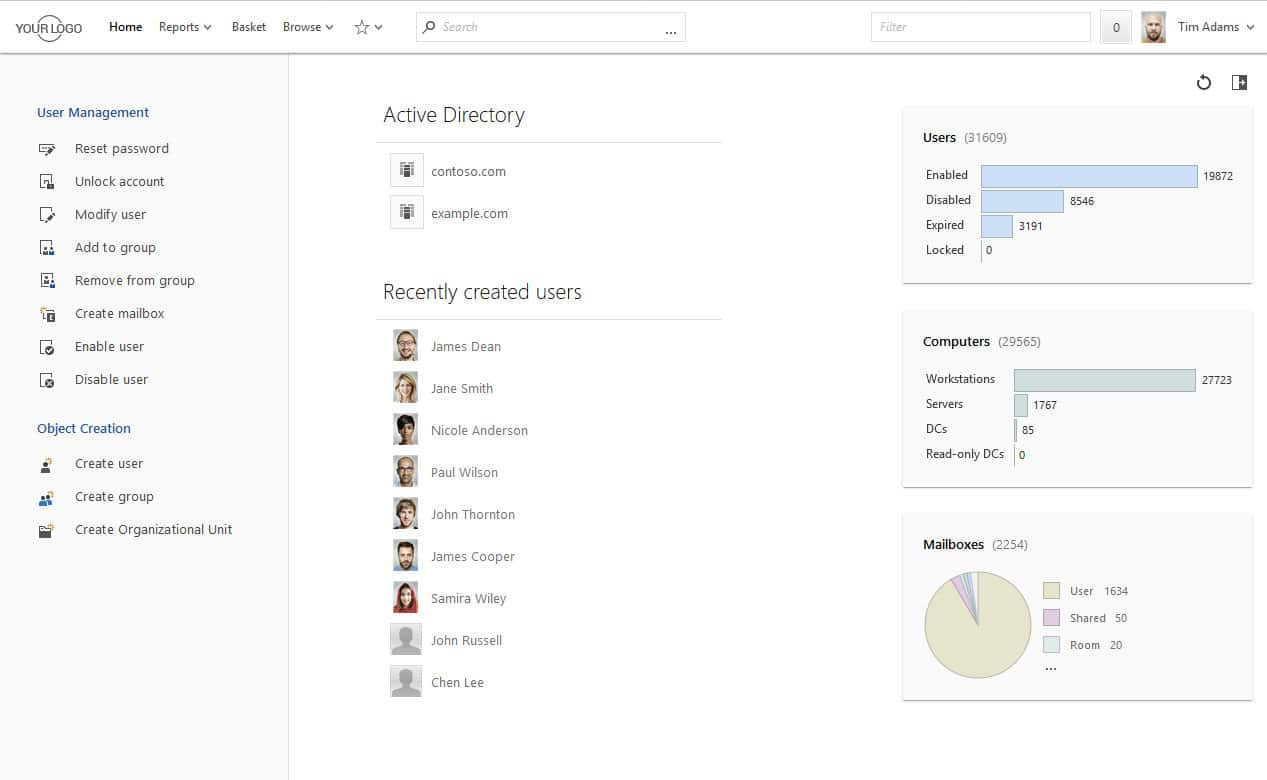
Adaxes is a software solution designed to streamline the automation and management of Active Directory (AD) and Microsoft Entra ID environments. From my research, Adaxes goes beyond basic administrative tasks by offering robust automation, delegation, and security features. By automating repetitive processes and enforcing organizational policies, Adaxes significantly improves efficiency and reduces the risk of errors.
Key Features:
- Automated User Provisioning: Automates the user provisioning process based on defined conditions.
- Flexible Approvals: Adaxes enables the addition of approval steps to virtually any operation within Active Directory (AD), Microsoft Entra ID, Exchange, and Microsoft 365.
- Data Standards Enforcement: Adaxes enforces corporate data standards by applying format restrictions to specific properties of objects, such as user accounts and groups.
- Password Self-Service: Empower users to reset forgotten passwords independently, reducing help desk calls and improving productivity.
- APIs for Integration: Provides several APIs that facilitate integration with external systems. These APIs allow programmatic access to Adaxes functionality, enabling seamless integration with existing IT infrastructure and tools.
Why Do We Recommend It?
Adaxes is recommended for its powerful features that optimize IT operations and bolster security in Active Directory management. Adaxes notably lightens the load on IT staff by automating routine tasks such as user provisioning and password management. Additionally, its self-service portal enables users to independently manage common tasks.
Who Is It Recommended For?
Adaxes is ideal for organizations with complex IT infrastructures. It empowers IT teams to efficiently manage hybrid environments, enforce security standards, and optimize overall operations.
Pros:
- Enhanced Efficiency: By automating user provisioning and other routine tasks, Adaxes reduces manual workload and accelerates administrative processes.
- Consistency and Compliance: Data standards helps enforce corporate data standards, ensuring that all objects in AD and Microsoft Entra ID conform to predefined formats and rules.
- Valuable Insights: The extensive collection of predefined reports offers valuable insights into the environment, aiding in monitoring, compliance, and analysis.
- Flexibility and Seamless Integration: The available APIs allow for flexible integration with other systems, making it easier to incorporate Adaxes into existing workflows and tools.
- Automated Onboarding: Simplifies user onboarding by automating provisioning tasks, making the process more efficient and less error-prone.
Cons:
- Initial Setup: Configuring Adaxes, particularly its approval workflows and data standards, can be complex and may require a learning curve.
- Dependency on Windows Ecosystem: Adaxes' integration is primarily focused on the Windows ecosystem, potentially limiting its compatibility with non-Microsoft environments.
3. Microsoft PowerShell
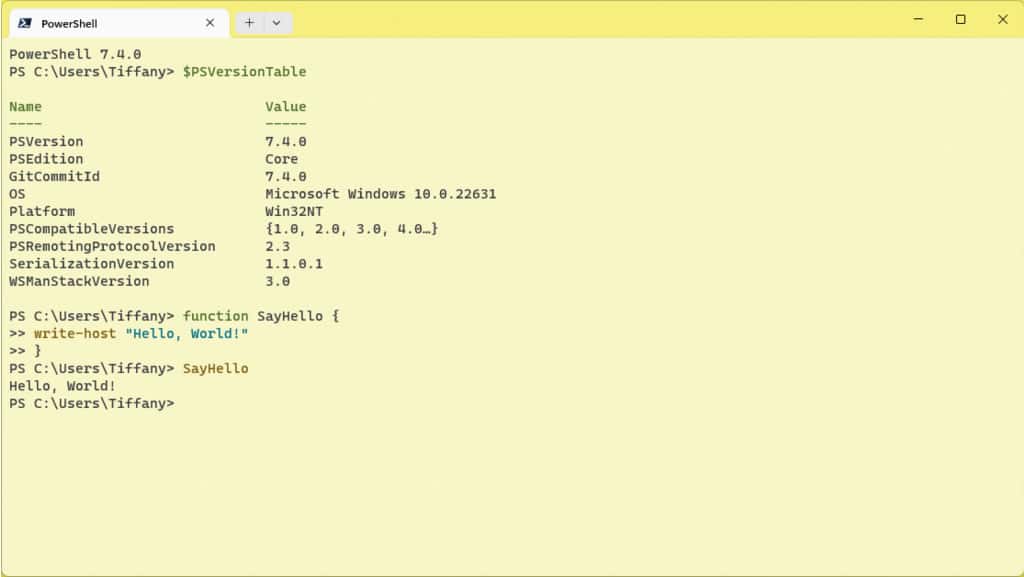
PowerShell is a robust scripting language and command-line shell developed by Microsoft. It provides administrators with granular control over various system components, including Active Directory.
Key Features:
- Remote Management: PowerShell offers remote management capabilities, enabling administrators to run scripts and commands across multiple servers and Active Directory instances from a single console.
- Integration Capabilities: PowerShell integrates with other Microsoft tools like Microsoft 365 and Azure AD, expanding its capabilities for managing complex IT environments..
- Auditing and Reporting: PowerShell scripts can be used to create comprehensive logs and reports on Active Directory activities, aiding in compliance, troubleshooting, and performance analysis.
- Task Scheduling: Administrators can schedule scripts to run at specific times or intervals using the Task Scheduler, ensuring routine AD tasks are performed automatically and consistently.
- Scripting and Automation: PowerShell empowers administrators to automate routine AD tasks like user account creation, group management, and permission assignments through scripting.
- Rich Set of Cmdlets: Provides a wide range of cmdlets specifically designed for AD management, covering almost all aspects of AD tasks.
By leveraging PowerShell, IT professionals can automate repetitive tasks such as Group management, User account creation, modification, and deletion. PowerShell's flexibility and integration with the Active Directory environment make it an indispensable tool for streamlining AD administration and improving overall efficiency.
Why Do We Recommend It?
PowerShell is the go-to tool for automating AD tasks. Its flexibility, deep integration with the Windows ecosystem, and powerful scripting capabilities make it invaluable for streamlining AD management and boosting efficiency.
Who Is It Recommended For?
PowerShell is best suited for IT professionals with some scripting experience as an AD automation tool. For those who invest time in learning it, PowerShell provides powerful automation capabilities that enhance AD management and overall IT efficiency.
Pros:
- Flexibility: PowerShell allows for the creation of highly customized scripts tailored to specific needs.
- Powerful Scripting: Allows for complex automation and customization.
- Integration: Integrates seamlessly with other Microsoft technologies and systems, facilitating comprehensive IT management..
- Community Support: A large community and extensive documentation provide valuable resources, tutorials, and support for troubleshooting and learning.
- Cost-Effective: As a built-in feature of Windows, PowerShell is widely available and does not require additional licensing costs, making it a cost-effective solution for AD automation.
- Community and Support: A large community of users and extensive online resources, including forums, tutorials, and script repositories, provide ample support for learning and troubleshooting.
Cons:
- Limited GUI: Primarily a command-line tool, lacking a user-friendly interface for some tasks.
- Steep Learning Curve: Mastering PowerShell scripting requires significant time and effort.
4. Netwrix Auditor
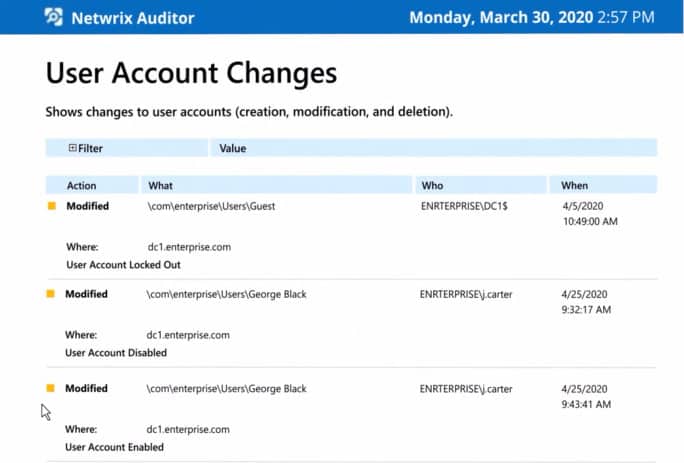
Netwrix Auditor is a specialized tool designed to monitor and audit AD changes. It provides security insights into Active Directory and Group Policy activities. It tracks changes and logins in Active Directory to reduce the risk of privilege abuse, ensure IT compliance, and simplify troubleshooting.
Key Features:
- Change Auditing: Tracks all modifications in Active Directory and Group Policy, providing detailed information on who made changes, what was changed, when, and where, including before and after values.
- Logon Auditing: Monitors both successful and failed logon attempts, including ADFS logons, and presents a complete history of user logins.
- Active Directory Risk Assessment: Identifies risks related to privilege management and user account handling, helping to address potential security gaps.
- Behavior Anomaly Discovery: Detects unusual activities that may indicate malicious insiders or compromised accounts, both on-premises and in the cloud.
- Security and Compliance Reporting: Offers pre-built reports aligned with various compliance standards such as PCI DSS, HIPAA, SOX, GDPR, GLBA, FISMA/NIST, and CJIS.
- Group Policy Monitoring: Reports changes to audit policies and other Group Policy settings with full details and before and after values.
- Interactive Google-like Search: Facilitates quick and precise searches through AD auditing data, with options to save searches as custom reports.
Netwrix Auditor helps identify potential security risks, streamline investigations, and meet regulatory requirements. It's an essential tool for maintaining a secure and compliant Active Directory environment.
Why Do We Recommend It?
Netwrix Auditor acts as a constant guardian, monitoring AD for suspicious activities. By tracking every change and logon, it provides critical insights to prevent security breaches and streamline incident response.
Who Is It Recommended For?
Netwrix Auditor is suitable for businesses of all sizes that prioritize AD security. It's especially beneficial for organizations subject to strict regulations and those handling sensitive information.
Pros:
- Non-Intrusive Architecture: Performs auditing without agents, preventing performance degradation or downtime.
- Alerts on Threat Patterns: Provides immediate notifications on critical changes, repeated failed logins, and other potential security threats.
- Detailed Reports and Dashboards: Provides comprehensive audit information with features for filtering, sorting, exporting, and scheduling reports.
- Compliance Ready: Aligns with a broad range of regulatory standards, simplifying compliance management.
- Ease of Use: Features intuitive search and reporting tools, making it easier to manage and analyze data.
- Enhanced Security: Provides robust tools for detecting anomalies and assessing risks, helping to prevent and address security issues.
Cons:
- Emphasize Monitoring Over Prevention: Although it detects threats, it does not actively prevent them; additional security measures are needed for that.
5. Quest Active Administrator
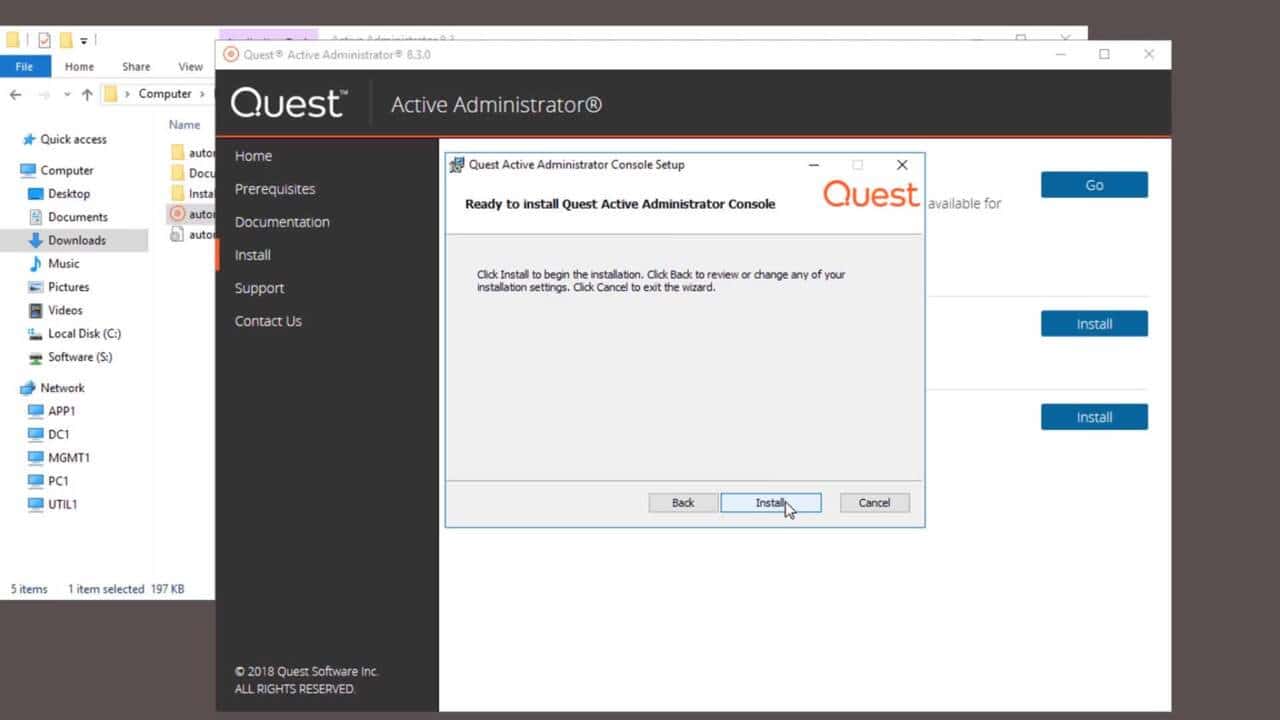
Active Administrator is an integrated solution from Quest Software for managing Microsoft Active Directory, designed to enhance your efficiency and agility beyond what native tools offer. It provides a unified view of Active Directory management, allowing you to fill gaps left by native tools and swiftly address auditing and security requirements. With its integrated AD administration and permissions management, you can ensure business boost IT efficiency, and reduce security risks.
Key Features:
- Automated Backup and Recovery: Schedule automated backups for AD and Group Policy. Recover entire objects or specific attributes, and roll back GPOs to previous states to ensure business continuity.
- Simplified Group Policy Management: Manage GPOs efficiently by copying, editing, and testing them in a secure, offline environment. It features comparison reports and automated checks to stay on top of changes and rollback if needed.
- AD Health Assessments: Monitor AD health with assessment reports and dashboards. Manage domain controllers, including adding, removing, and rebooting, through the DC Management Module.
- Integrated Administration: Proactively manage AD to enhance auditing, security, productivity, and business continuity.
- Authorization Management: Assess and standardize security policies and permissions to eliminate over-privileged users.
Why Do We Recommend It?
Quest Active Administrator is a robust tool designed to streamline Active Directory management. It offers a comprehensive suite of features for automating routine tasks, managing user and group accounts, and ensuring AD health. By consolidating AD management into a single console, it enhances efficiency and reduces the risk of errors.
Who Is It Recommended For?
Quest Active Administrator is ideal for IT teams managing large-scale AD infrastructures. It is particularly beneficial for organizations with complex AD environments requiring advanced management capabilities and a focus on security and compliance.
Pros:
- Enhanced Visibility and Control: Provides comprehensive reporting and alerting features, allowing for proactive management and quick responses to unauthorized changes.
- Time-Saving Automation: Automated backup and recovery streamline administrative tasks and protect against data loss.
- Improved GPO Management: Advanced tools for managing, testing, and rolling back Group Policy Objects improve efficiency and reduce risk.
- Health Monitoring: Detailed assessments and dashboards help maintain AD health and performance, ensuring availability and reliability.
- Efficient Security Management: Customizable templates and streamlined permission management help maintain tight security and prevent over-privileged accounts.
- Intuitive Reporting and Alerting: Easily monitor and report on changes with filters for event type, user, and date. Configure event alerts and automate responses to address improper AD changes swiftly.
Cons:
- Learning Curve: Advanced features and functionalities require time to learn and fully utilize, potentially leading to a steeper learning curve for new users.
- Complexity: While it offers extensive capabilities, the complexity of the tool might be overwhelming for organizations with simpler AD management needs or limited IT resources.
6. Active Directory Users and Computers
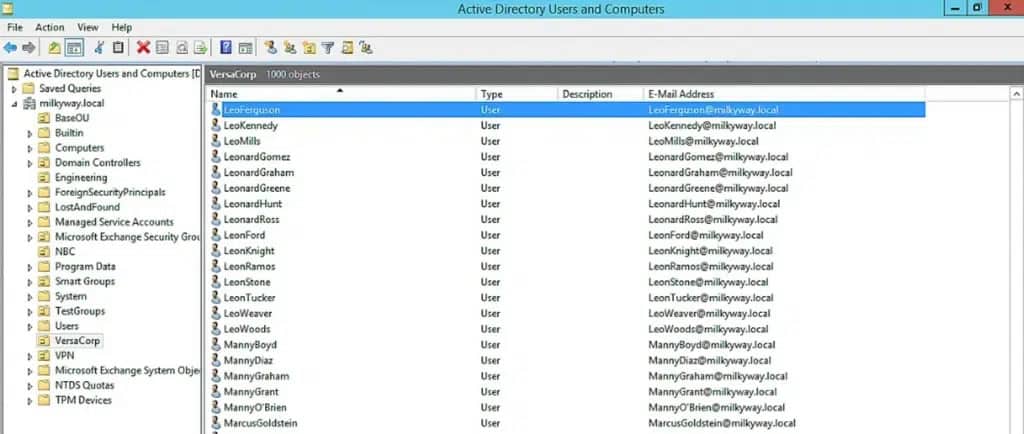
Active Directory Users and Computers (ADUC) is a Microsoft Management Console (MMC) snap-in used to manage Active Directory (AD). It provides a graphical interface for administering various AD objects, such as computers, users, groups, and organizational units (OU). ADUC is a fundamental tool for managing AD, but it has limitations in terms of automation and scalability for large environments.
Key Features:
- User Management: Create, modify, and delete user accounts. You can reset passwords, enable or disable accounts, and manage user properties such as group memberships and profile paths.
- Group Management: Create, modify, and delete security groups and distribution groups. You can manage group memberships and set permissions for these groups.
- Computer Management: You can manage computer properties and view the organizational units (OUs) where computers are located.
- Organizational Units (OUs): Create and manage OUs, which are used to organize and group objects within Active Directory.
- Delegation of Control: Assign specific administrative permissions to users or groups, allowing them to manage certain aspects of AD without granting them full control.
- Attribute Editing: View and edit the attributes of AD objects. This includes custom attributes or any attributes that are not directly exposed through the standard ADUC interface.
- Group Policy Management: While ADUC itself doesn’t manage Group Policies directly, you can view and link GPOs (Group Policy Objects) to OUs, which impacts the settings applied to users and computers within those OUs.
Why Do We Recommend It?
ADUC is a foundational tool for managing Active Directory. Its straightforward interface makes it accessible to administrators of all levels, allowing for basic user and computer management. While it may lack advanced features, ADUC remains valuable for smaller organizations or for performing simple administrative tasks.
Who Is It Recommended For?
ADUC is recommended primarily for IT administrators and system engineers who are responsible for the day-to-day management of Active Directory in a Windows Server environment.
Pros:
- Included with Windows Server: ADUC is a built-in management tool provided as part of the Windows Server operating system.
- No Extra Licensing: There are no additional licensing costs specifically for using ADUC. It is available as part of the core functionality of Windows Server, which includes Active Directory Domain Services (AD DS).
- Centralized Management: ADUC provides a centralized console for managing users, groups, computers, and other AD objects, streamlining administrative tasks, and reducing the need for multiple tools.
- Integration with Group Policy: While ADUC itself doesn’t manage Group Policies directly, it allows you to link OUs to Group Policy Objects (GPOs), which can then be used to enforce policies across users and computers in those OUs.
- Ease of Use: The graphical interface is intuitive, which helps reduce the learning curve for new administrators.
- Integration with Other Tools: ADUC integrates well with PowerShell; and Many third-party tools and scripts are designed to work with it, enhancing its functionality.
Cons:
- Limited Automation: Manual tasks can be time-consuming for large environments.
- Lack of Advanced Features: Does not offer complex features like RBAC or detailed reporting.
- Scalability Issues: Can become cumbersome for managing large-scale AD deployments.
